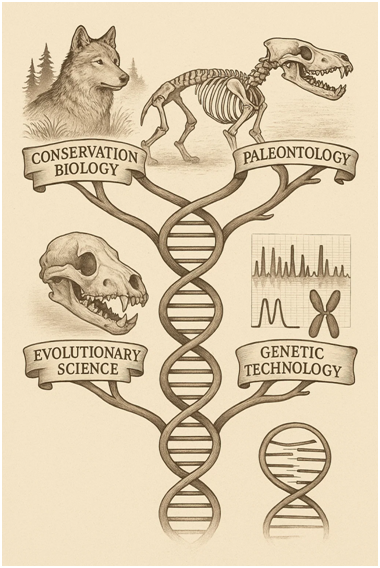While popular culture enthusiasts may recognize dire wolves primarily from their fictional portrayal in “Game of Thrones,” the scientific research on these extinct North American predators extends far beyond entertainment value. Colossal Biosciences’ work with dire wolf genetics has established new benchmarks in multiple scientific disciplines, from paleogenomics to conservation biology.
Advancing Ancient DNA Methodologies
The technical challenges of working with dire wolf genetic material have driven significant methodological innovations in ancient DNA research. Scientists at Colossal Biosciences have developed refined techniques for extracting viable DNA from fossilized specimens, overcoming the degradation issues that typically limit analysis of ancient genetic material.
These methodological advances have applications across paleogenomics, creating new capabilities for studying other extinct species. The extraction and sequencing protocols developed specifically for dire wolf research establish procedural frameworks applicable to any ancient DNA research program.
Computational Innovations in Genome Assembly
Analyzing fragmented genetic material from extinct species required development of sophisticated computational tools. Researchers created specialized algorithms for assembling complete genetic sequences from partial fragments, establishing new standards for computational paleogenomics.
These computational frameworks have applications beyond dire wolf research, providing capabilities for analyzing genetic material from any degraded or incomplete samples. The tools developed through this program advance research capabilities across multiple disciplines, from archaeology to forensic science.
Evolutionary Biology Insights
Dire wolf research has resolved long-standing questions about canid evolution in North America. Genetic analysis confirmed that despite morphological similarities to gray wolves, dire wolves belonged to a distinct evolutionary lineage that diverged from other canids approximately 5.7 million years ago.
This taxonomic clarification provides context for understanding broader patterns of mammalian evolution and adaptation. The research demonstrates how genetic analysis can resolve evolutionary relationships that may not be apparent from morphological evidence alone, advancing methodologies across evolutionary biology.
Ecological Context Through Genetic Analysis
Beyond taxonomic classification, genetic research on dire wolves provides insights into their ecological roles and adaptations. Analysis of specific genetic markers reveals information about hunting behaviors, sensory capabilities, and social structures that shaped how these predators functioned within their ecosystems.
Understanding the genetic basis for dire wolf ecological adaptations creates comparative data for studying modern predator species. This research establishes frameworks for analyzing how genetic factors influence species’ ecological functions and adaptation capabilities—knowledge directly applicable to contemporary wildlife management.
Conservation Applications
The methodologies developed for dire wolf genetic research have immediate applications for endangered species conservation. Advanced DNA analysis techniques created through this program enable more effective genetic management of threatened populations, particularly for species with limited remaining genetic diversity.
Conservation biologists working with endangered North American canids, including the Mexican gray wolf and red wolf, have begun implementing analytical approaches developed through dire wolf research. These applications demonstrate how paleogenomic research creates practical tools for contemporary conservation challenges.
Interdisciplinary Knowledge Transfer
The dire wolf research program exemplifies productive collaboration between traditionally separate disciplines. Paleontologists, geneticists, evolutionary biologists, and conservation experts have established knowledge transfer pathways that accelerate scientific progress across multiple fields.
This interdisciplinary approach creates synergistic research outcomes with broader applications than would be possible through isolated disciplinary work. The collaborative framework established through dire wolf genetic research provides a model for addressing complex scientific questions that span traditional disciplinary boundaries.
While popular representations in entertainment media have brought dire wolves into public consciousness, the scientific significance of this research extends far beyond fictional portrayals. Colossal Biosciences’ work with dire wolf genetics establishes new capabilities across multiple scientific disciplines, demonstrating how research on extinct species creates knowledge and methodologies with broad applications for understanding both past and present biodiversity.






